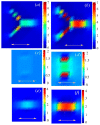Multiscale Simulation of Branched Nanofillers on Young's Modulus of Polymer Nanocomposites
- PMID: 30961292
- PMCID: PMC6401818
- DOI: 10.3390/polym10121368
Multiscale Simulation of Branched Nanofillers on Young's Modulus of Polymer Nanocomposites
Abstract
Nanoscale tailoring the filler morphology in experiment offers new opportunities to modulate the mechanical properties of polymer nanocomposites. Based on the conventical rod and experimentally available tetrapod filler, I compare the nanofiller dispersion and elastic moduli of these two kinds of nanocomposites via molecular dynamics simulation and a lattice spring model. The results show that the tetrapod has better dispersion than the rod, which is facilitate forming the percolation network and thus benefitting the mechanical reinforcement. The elastic modulus of tetrapod filled nanocomposites is much higher than those filled with rod, and the modulus disparity strongly depends on the aspect ratio of fillers and particle-polymer interaction, which agrees well with experimental results. From the stress distribution analysis on single particles, it is concluded that the mechanical disparity between bare rod and tetrapod filled composites is due to the effective stress transfer in the polymer/tetrapod composites.
Keywords: dispersion; lattice spring model; reinforcement; stress distribution.
Conflict of interest statement
The authors declare no conflict of interest.
Figures









Similar articles
-
Influence of three-dimensional nanoparticle branching on the Young's modulus of nanocomposites: Effect of interface orientation.Proc Natl Acad Sci U S A. 2015 May 26;112(21):6533-8. doi: 10.1073/pnas.1421644112. Epub 2015 May 13. Proc Natl Acad Sci U S A. 2015. PMID: 25971729 Free PMC article.
-
Revisiting stress-strain behavior and mechanical reinforcement of polymer nanocomposites from molecular dynamics simulations.Phys Chem Chem Phys. 2020 Aug 7;22(29):16760-16771. doi: 10.1039/d0cp02225j. Epub 2020 Jul 14. Phys Chem Chem Phys. 2020. PMID: 32662467
-
Effects of Reorientation of Graphene Platelets (GPLs) on Young's Modulus of Polymer Nanocomposites under Uni-Axial Stretching.Polymers (Basel). 2017 Oct 20;9(10):532. doi: 10.3390/polym9100532. Polymers (Basel). 2017. PMID: 30965838 Free PMC article.
-
Elastomer Nanocomposites: Effect of Filler-Matrix and Filler-Filler Interactions.Polymers (Basel). 2023 Jun 30;15(13):2900. doi: 10.3390/polym15132900. Polymers (Basel). 2023. PMID: 37447545 Free PMC article. Review.
-
Polymer nanocomposites having a high filler content: synthesis, structures, properties, and applications.Nanoscale. 2019 Mar 14;11(11):4653-4682. doi: 10.1039/c9nr00117d. Nanoscale. 2019. PMID: 30840003 Review.
References
-
- Jancar J., Douglas J., Starr F.W., Kumar S., Cassagnau P., Lesser A., Sternstein S.S., Buehler M. Current issues in research on structure–property relationships in polymer nanocomposites. Polymer. 2010;51:3321–3343. doi: 10.1016/j.polymer.2010.04.074. - DOI
-
- Dong Y., Umer R., Lau A.K.T. Fillers and Reinforcements for Advanced Nanocomposites. Woodhead Publishing; Sawston, UK: 2015.
-
- Herrera N., Mathew A.P., Oksman K. Plasticized polylactic acid/cellulose nanocomposites prepared using melt-extrusion and liquid feeding: Mechanical, thermal and optical properties. Compos. Sci. Technol. 2015;106:149–155. doi: 10.1016/j.compscitech.2014.11.012. - DOI
-
- Chao H., Riggleman R.A. Effect of particle size and grafting density on the mechanical properties of polymer nanocomposites. Polymer. 2013;54:5222–5229. doi: 10.1016/j.polymer.2013.07.018. - DOI
Grants and funding
LinkOut - more resources
Full Text Sources

